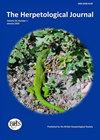Chytrid infection in Asia: How much do we know and what else do we need to know?
IF 1.1
4区 生物学
Q3 ZOOLOGY
引用次数: 12
Abstract
We conducted a systematic review to evaluate the knowledge base for amphibian chytrid Batrachochytrium dendrobatidis (Bd) infection in the continent of Asia. Despite an indication of geographic bias in terms of studying chytrid fungus distribution in Asia, 167 amphibian species (145 spp. native to Asia) from 16 countries have been reported as infected with Bd. Our meta-analysis shows that overall prevalence is 8.19 % (out of 28,433 samples), and Bd-positive rate in amphibia significantly varies among sampling sources (χ2= 380.57, DF= 6, P< 0.001) and age categories (χ2= 22.09, DF= 2, P< 0.001). We used Kernel Density analysis to produce a hotspot map for chytrid infection, and Digital Elevation Model to understand the distribution of chytrid positive locations across different elevations. In our meta-analysis, most of the Bd-positive sites range between 4.45–27.49 °C, 167–4,353 mm rainfall, 10–40°N, and at lower elevations (<500 m). Using land cover analysis, we did not find a statistically significant difference among six different land cover categories in relation to the prevalence of Bd across Asia. Although no mass die-off events have been reported so far, Maximum Entropy modelling shows that Bd distribution and infection may potentially occur across a vast region of south-east Asia. In conclusion, we call for more systematic research and monitoring strategies in place for countries with little to no information, but have a moderately higher risk of chytrid distribution and infection.亚洲壶菌感染:我们知道多少?我们还需要知道什么?
我们进行了一项系统综述,以评估亚洲大陆两栖动物壶菌Batrachochytrium dendrobatidis(Bd)感染的知识库。尽管在研究壶菌在亚洲的分布方面存在地理偏见,但据报道,来自16个国家的167种两栖动物(145种原产于亚洲)感染了Bd。我们的荟萃分析显示,总体患病率为8.19%(在28433个样本中),两栖动物的Bd阳性率在采样源(χ2=380.57,DF=6,P<0.001)和年龄类别(χ2=22.09,DF=2,P<0.001。在我们的荟萃分析中,大多数Bd阳性位点的温度范围在4.45–27.49°C、167–4353 mm降雨量、10–40°N之间,海拔较低(<500 m)。使用土地覆盖分析,我们没有发现六种不同的土地覆盖类别与亚洲Bd流行率之间存在统计学上的显著差异。尽管到目前为止还没有大规模死亡事件的报道,但最大熵模型显示,Bd的分布和感染可能发生在东南亚的广大地区。总之,我们呼吁对信息很少或根本没有信息,但乳糜泻分布和感染风险略高的国家进行更系统的研究和监测。
本文章由计算机程序翻译,如有差异,请以英文原文为准。
求助全文
约1分钟内获得全文
求助全文
来源期刊

Herpetological Journal
生物-动物学
CiteScore
2.40
自引率
10.00%
发文量
25
审稿时长
>12 weeks
期刊介绍:
The Herpetological Journal is the Society''s prestigious quarterly scientific journal.
 求助内容:
求助内容: 应助结果提醒方式:
应助结果提醒方式:


